You’re ready to start fermenting! GREAT! Now, where do you begin? Here’s an in-depth look at the best fermentation vessels for safe, affordable, and easy fruit and veggie ferments like garlic-dill pickles, carrot sticks, radishes, and sauerkraut.
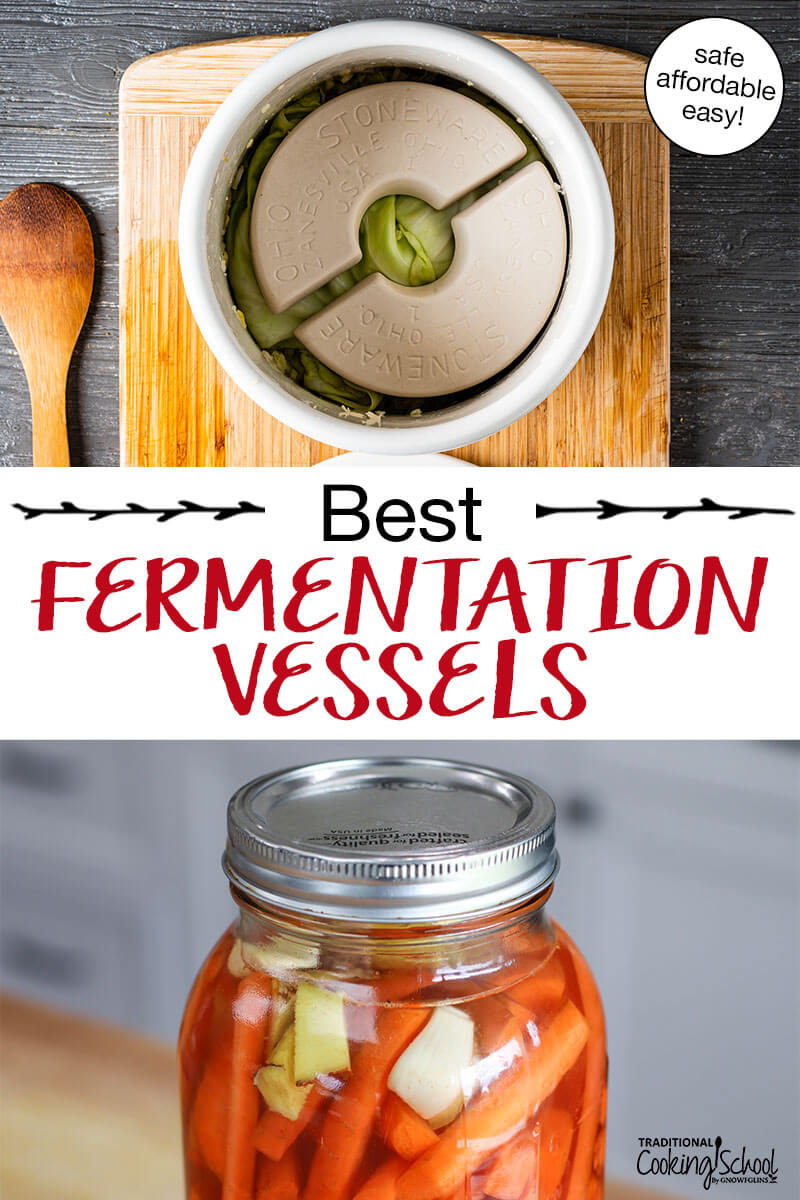
MYTH: You need special equipment to ferment.
Not at all!
Although wooden pounders, fermenting weights, fermenting lids, crocks, etc. are all very nice… you can do without. You can use what you already have, whether that’s jars, crocks, bowls, wooden barrels or buckets (preferably food grade).
Whatever you choose, the main idea is to make the container as air-tight as possible, and keep the food submerged under the level of the brine.
Let’s cover some fermenting basics and then I’ll share my favorite fermenting vessels!
Table Of Contents
What is fermentation?
The fermentation process starts with beneficial organisms called Lactobacilli. These are bacteria that produce lactic acid (and carbon dioxide) as a byproduct of consuming the starches and sugars in food. As they grow and proliferate throughout the food (making it probiotic), they boost vitamin and enzyme levels.
You can lacto-ferment fruits, vegetables, grains, beans, meats, dairy, beverages, condiments and more (all of which we cover in our Lacto-Fermentation eCourse).

Why Fermentation Vessels Matter
Generally, lacto-fermentation is an anaerobic process; it requires an oxygen-free environment. If oxygen is present, the wrong organisms flourish instead of the friendly bacteria and/or yeasts we want to cultivate.
You might notice whitish or other colored growths on the top of your ferments at times (especially during warm weather). This is an over-growth of oxygen-loving yeast (not harmful) or spoiling organisms, right at the surface. Neither of these are the right organisms for lacto-fermentation. They can lend off-flavors to your ferments or cause them to spoil.
So, it’s important to choose fermentation vessels that support the growth of friendly bacteria instead of spoiling organisms. The best fermentation vessels are air-tight. Which leads me to our next question…
Should fermenting vessels be air-tight?
Some ferments (sourdough and cultured dairy) need oxygen, but most don’t and shouldn’t. For the fermentation that doesn’t need oxygen, ideally you should seal up the vessels completely to minimize the contact with spoiling organisms from the outside.
You can, and people do, use other containers which are not air-tight. For example, if you’re using a crock from Goodwill that comes without a lid. Or some people make sauerkraut in big bowls and weigh the sauerkraut down with a rock on top of a plate — obviously exposed to the air at least around the edges of the plate.
In these situations, keeping the food away from oxygen means getting creative. In past or recent history, people employed various solutions, such as wooden planks, plates with plastic bags full of water on top, and other things. These setups should be checked for mold at the surface regularly. Usually, the mold will not trickle down further if other conditions are right.
The basic idea is to keep the spoiling organisms in the outside air away from your ferment. Yet, even if you use an airlock jar there are no guarantees. The top of the ferment is still exposed to the air in the jar. Don’t worry, mold isn’t as scary as it sounds. I walk you through how to prevent moldy ferments and what to do if it happens, including how to tell if they are safe to eat or not, in this article.
A general rule: Let your nose be your guide. If the fermenting food smells spoiled, it probably is. Toss it. If you need more help, here is my in-depth guide to troubleshooting ferments.
How do fermentation vessels work?
Some are completely air-tight (such as Mason jars). Others have a water barrier which keeps outside air out, yet allows gases produced by the fermenting organisms to escape (such as airlock jars and some crocks).
My Favorite Fermenting Vessels
I like to keep my kitchen and its implements simple. 😉 So I opt for simple fermenting vessels — a few special airlock lids and crocks, and lots of canning jars!
Whatever you choose, keep in mind the idea of the brine and keeping food submerged. Glass and lead-free ceramic are best. Avoid plastic, as the acids in the fermented foods may leech plastic into your food.
Here are my favorite fermenting vessels. They are all air-tight, as that is my preference. (However, I don’t use air-tight containers for sourdough or cultured dairy.)
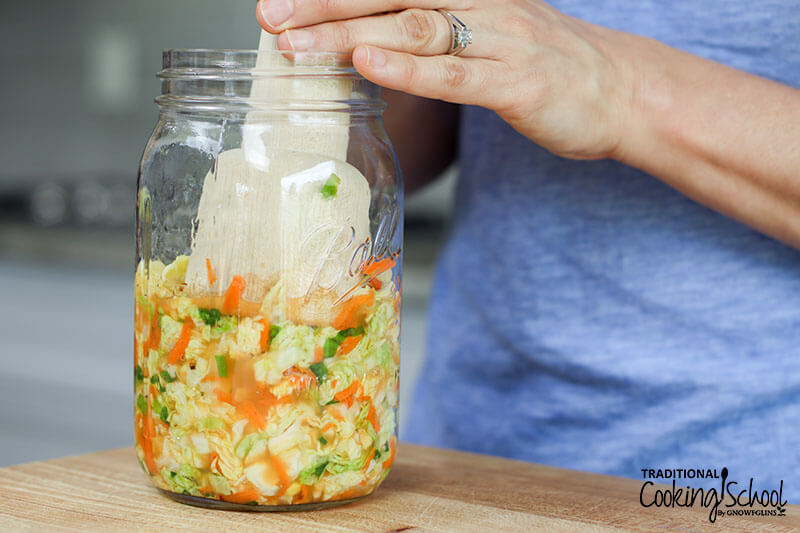
1. Mason Jar with Metal Band and Lid
We’ve all got Mason jars, and they come in a variety of sizes to suit your fermenting needs!
Leave 1 inch of space at the top for the production of acids and gases, and be sure to cap tightly with the metal band and lid. Burp the jar daily to release pent-up gases, or you may have an explosion on your hands (especially in warm weather). You may also need to tamp the fermented foods back down underneath the level of the brine (pictured above).
You can use a clean regular mouth lid right inside a wide-mouth jar to hold the veggies or fruit down and even weigh it down with a glass of water (just heavy enough to press the food down under the brine but no more) or a clean, sterilized rock.
Pros: Inexpensive, versatile and many sizes.
Cons: Burping the jar releases somewhat stinky (but not harmful) odors. Built-up pressure can cause explosions or very bubbly mixtures. Use of metal band and lid may be reactive with acids in fermentation and/or may contain BPA. You need to come up with your own weights for buoyant foods.
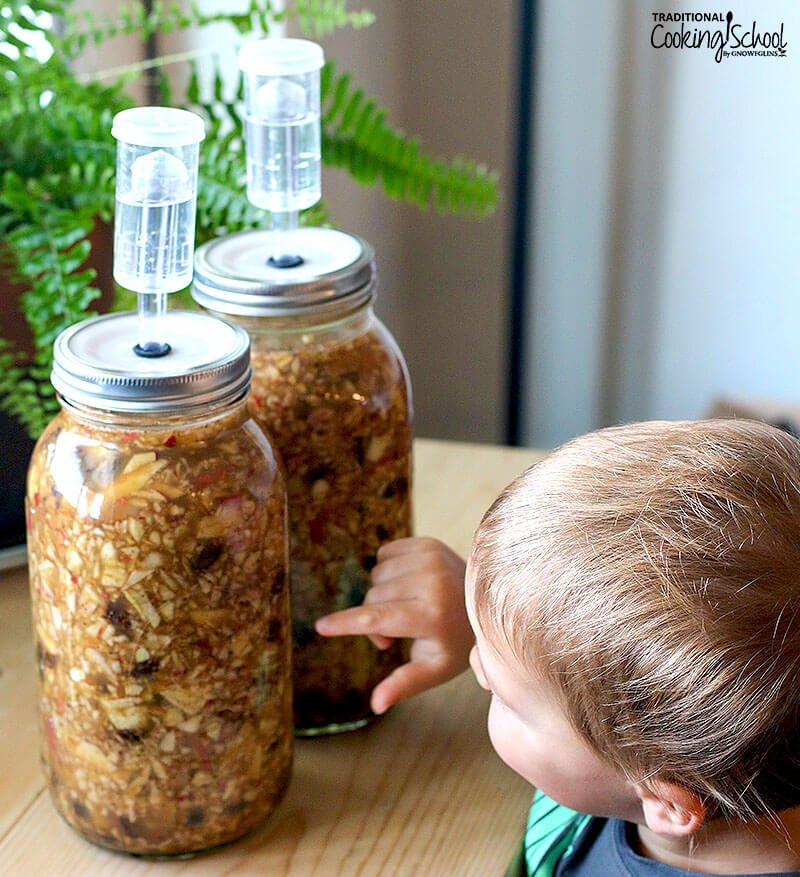
2. Airlock Jars
To upgrade your Mason jar set-up, you can purchase an airlock lid that uses a water barrier to keep outside air from entering the jar, yet allows fermenting gases to escape. My favorites are the Pickl-Pro lids from Homesteader Supply and the Fermented Vegetable Master from Cultures for Health.
The lids are not metal but rather food-grade plastic. 1 inch of head space is necessary here, too. Whenever I push the limit, I end up with very happy kraut juice all over my counter. Be sure to press down the ferment so it stays submerged under the brine, too.
You can also make your own (very inexpensive) DIY airlock solution!
Pros: Food-grade plastic lid rather than reactive metal, versatile and many sizes. Airlock allows fermenting gases to escape while keeping outside air out. This eliminates the need to burp container, protects against explosions, and reduces stinky smells.
Cons: More expensive, though not terribly so. Do not include weights for food, though there are exceptions.
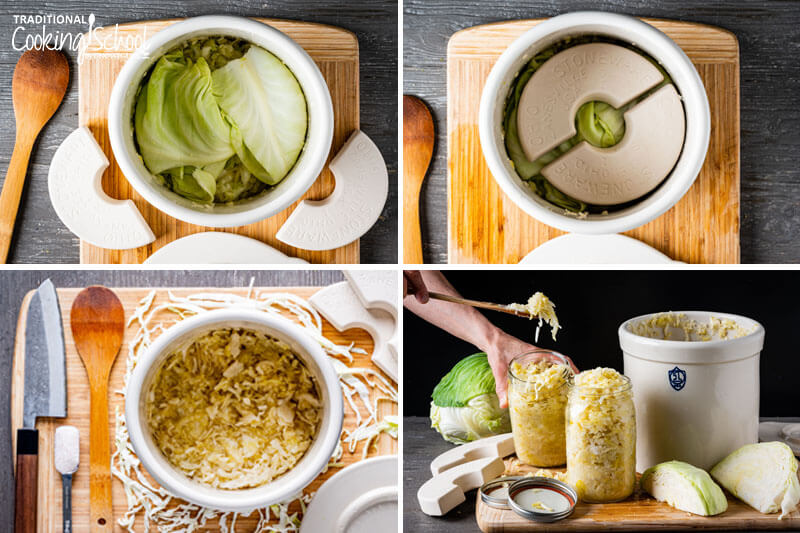
3. Fermenting Crocks
Fermenting crocks are cream of the crop. They are more expensive than Mason jars, yet can still be affordable. The crocks have weight stones to submerge the food below the brine. A water gutter allows fermenting gases to escape but prevents outside air from getting in. You need to leave room at the top here as well, enough for the weight and for brine and acids.
Ohio Stoneware is my favorite brand of stoneware fermentation crocks. Their USA-made products are fantastic and affordable. I demonstrated how to use their 1-gallon crocks to make homemade sauerkraut here. They also have larger traditional style crocks with a water gutter to keep them air-tight (we have a 3 gallon size of that style).
Follow the links below to check out their stoneware fermentation crocks for yourself!
- Complete 1-gallon kit from Ohio Stoneware — includes crock, weights, and lid (pictured above)
- 1-gallon crock from Ohio Stoneware
- Lid for 1-gallon crock from Ohio Stoneware
- Ohio Stoneware weights for 1-gallon crock
Pros: Versatile and many sizes. Can include weights. Water gutter allows fermenting gases to escape while keeping outside air out — eliminates need to burp container, protects against explosions and reduces stinky smells.
Cons: More expensive. Water gutter must be refilled on a regular basis, depending on speed of evaporation.
Other Fermentation Posts You May Enjoy
Feel free to check out these fermenting articles and recipes, all found in our fermenting archives!
- What Is Lacto-Fermentation? {Video}
- 5 Tips: How To Prevent Mold During Fermentation #AskWardee 074
- How To Make Lacto-Fermented Radishes
- Homemade Sauerkraut In A Stoneware Crock
- Lacto-Fermented Carrot Sticks (gut-healing probiotic snack for kids!)
- Old-Fashioned, Crunchy, Fermented Garlic-Dill Pickles
What are your favorite fermentation vessels?
...without giving up the foods you love or spending all day in the kitchen!

2 free books:
Eat God's Way
Ditch the Standard American Diet, get healthier & happier, and save money on groceries...
We only recommend products and services we wholeheartedly endorse. This post may contain special links through which we earn a small commission if you make a purchase (though your price is the same).
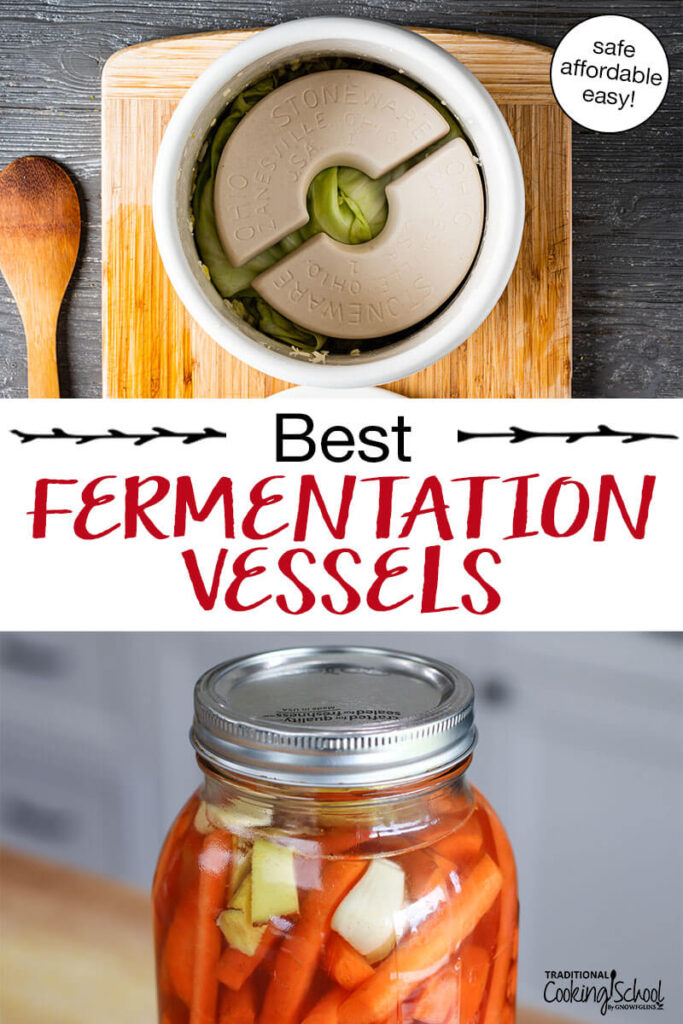
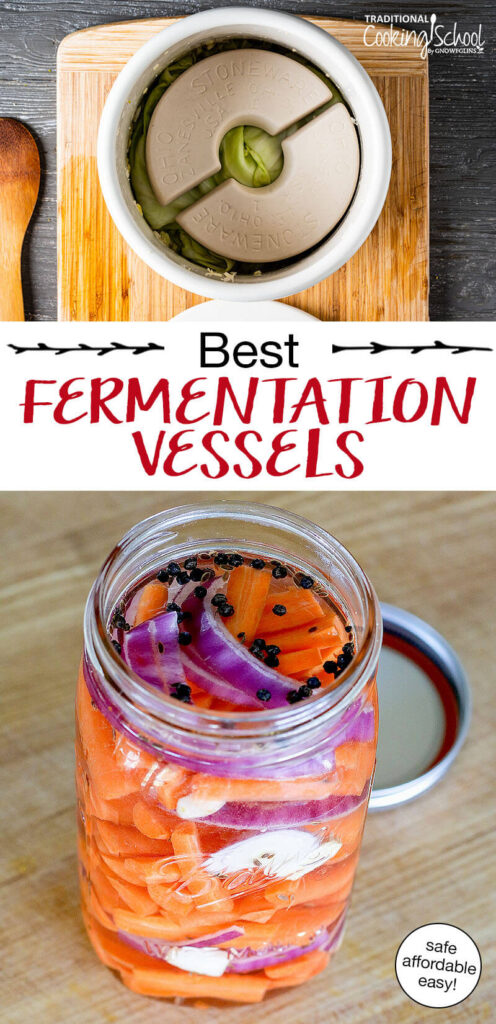
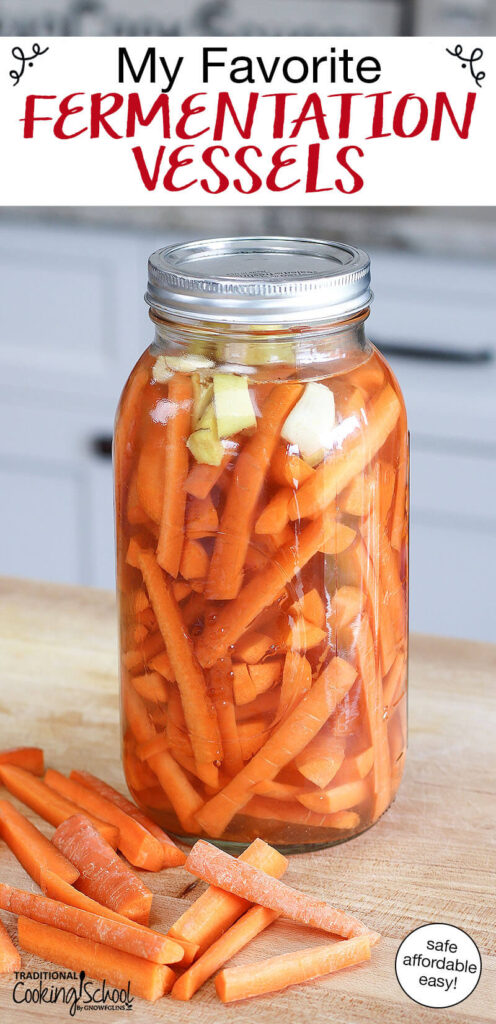
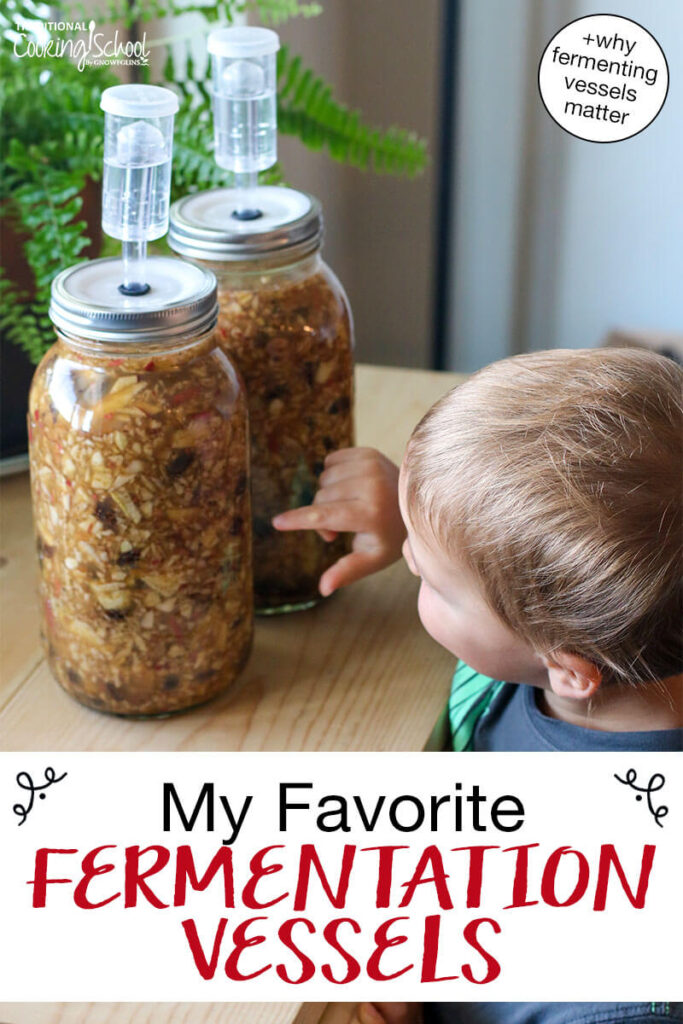
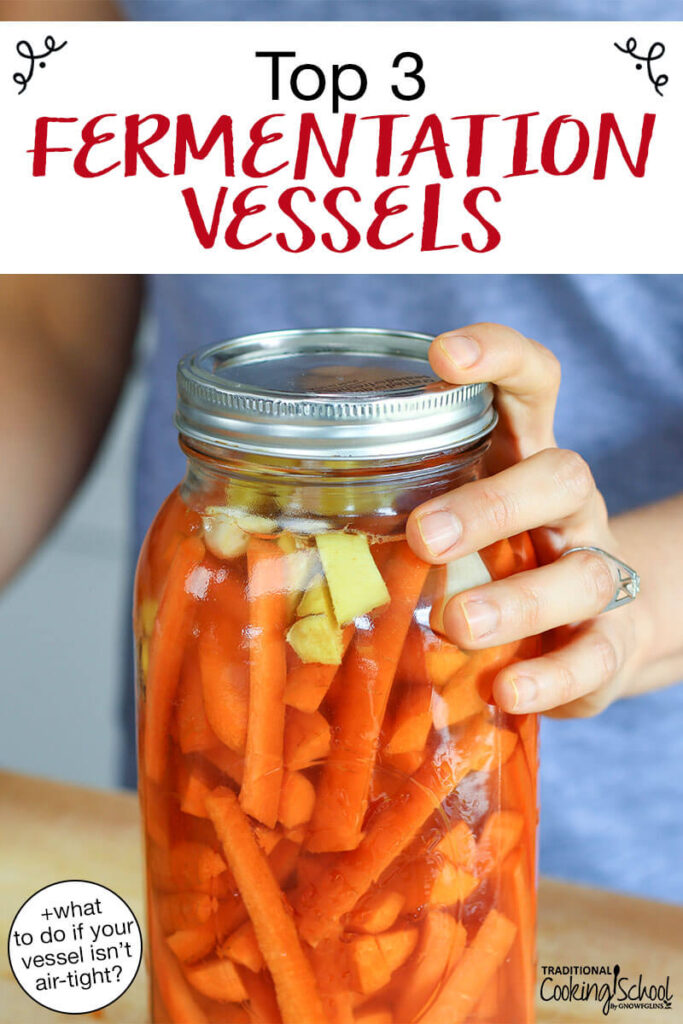
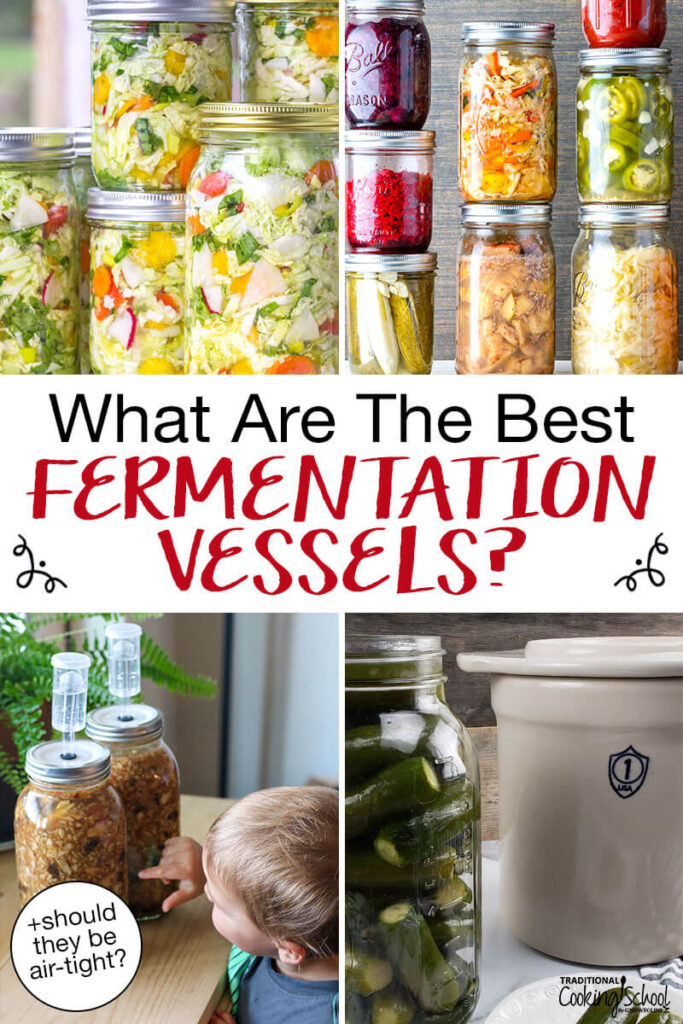
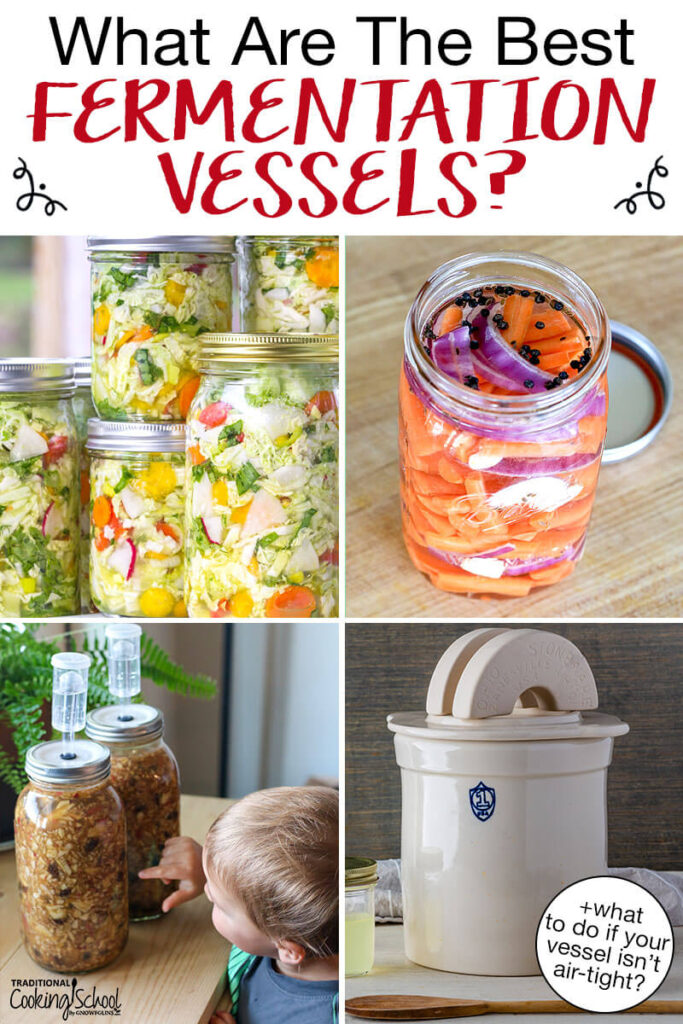
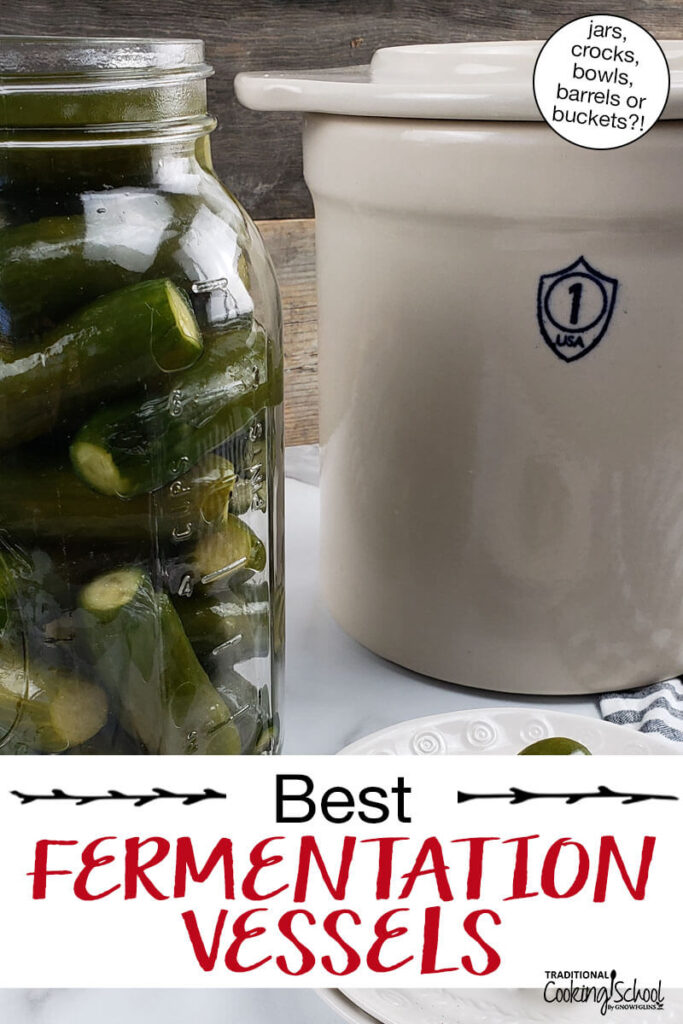
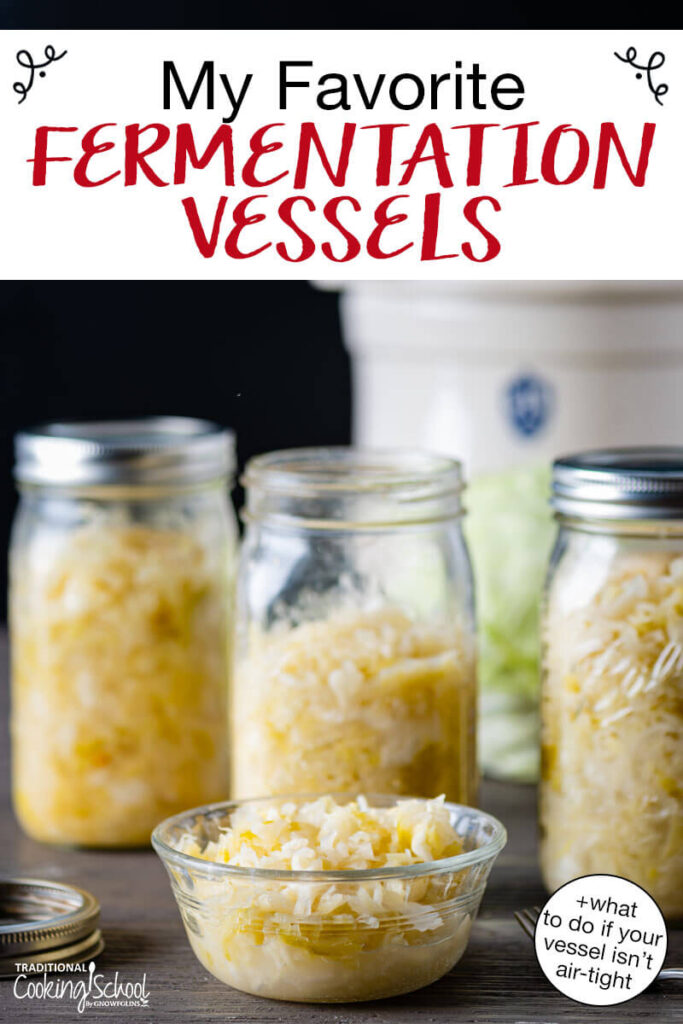

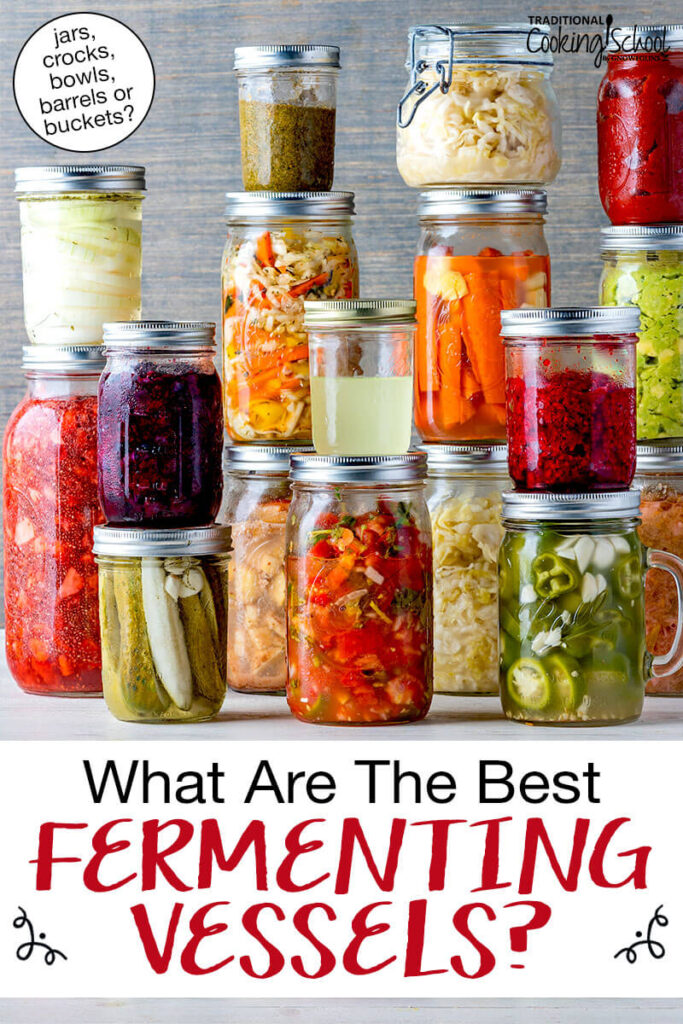
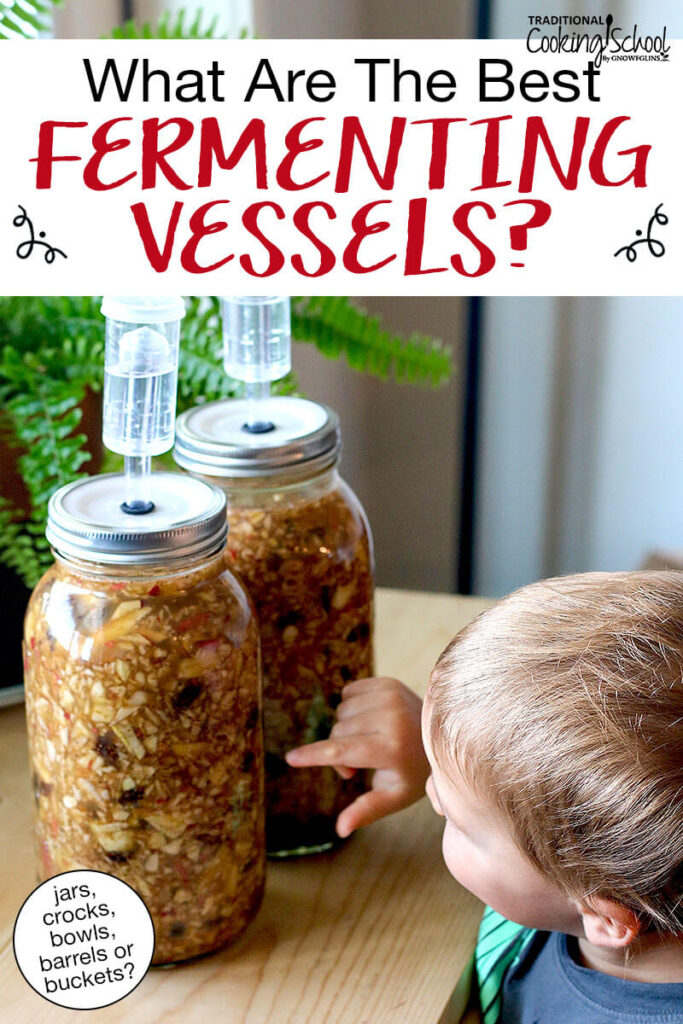

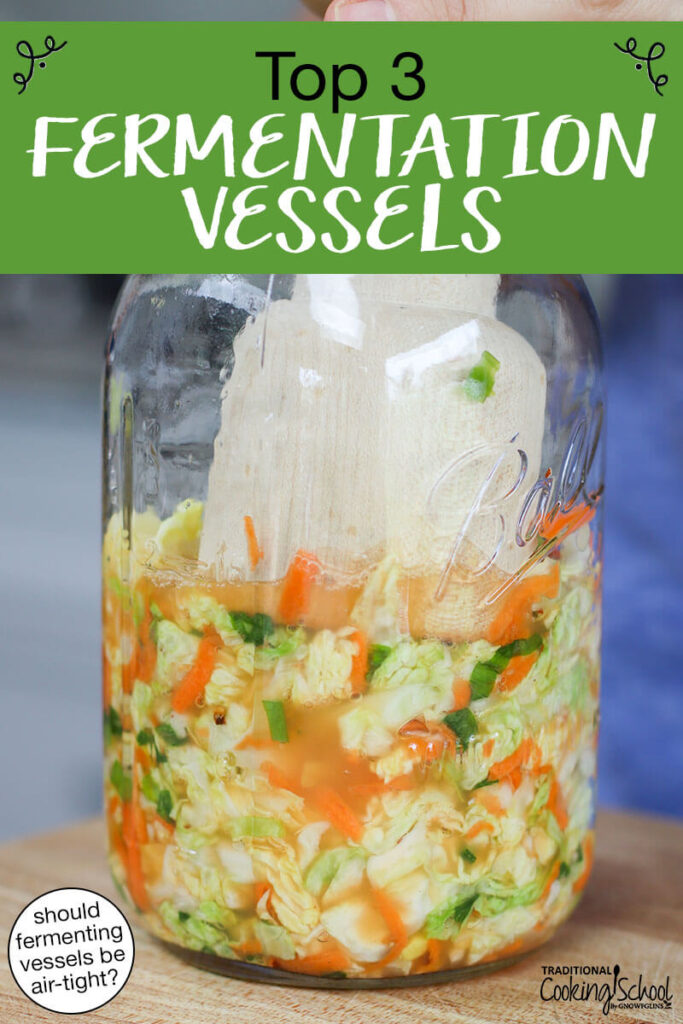
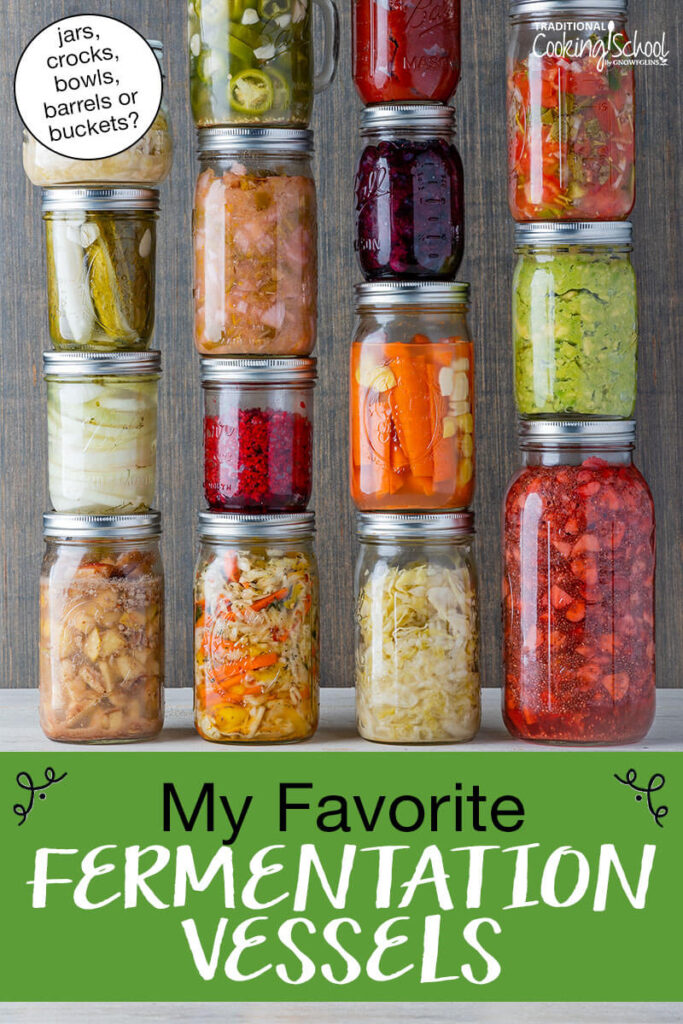


Great post! I am going to link to it from our Christian Health Cooperative website/forums- if you don’t mind. As far a fermenting tools- I also like the Pickl-it… http://www.pickl-it.com. … but am not a fan of the heafty pricetag for the average jane- so I also advocate to my group of gals to either make their own (you can buy many of the tools at wine-making or beer bottling stores) or simply use one of the time-honored tools like the mason jar which is not ideal because they are not airtight- but has worked for years and is even the go-to choice of many-o-fermenting masters. I am no expert, tho, so I just work with the info I have. My goal is to help ladies start fermenting and eating healthy- even if they don’t have alot of $$ to do so! 😉
Megan — I’d be happy for you to share this! 🙂
Why do you say the mason jars are not air-tight? With the metal band and lid, they are. Of course, when we open them to burp them, there is a reintroduction of air — is that what you mean?
Thanks for sharing your ideas and tips!
From what I understand, unless you use heat to seal the lids, they are not air tight.
I bought a crock with a spiggot for my Kombucha. It is great!
Post a picture or a link Amy !
I bought an old round crock pot at the thrift store. Took the inside part out and threw away the rest. A saucer fits perfectly inside and I used a jar of water for the weight. Two medium heads of cabbage filled it about halfway, next time I’ll use three. The kraut turned out perfect.
Great post – thanks so much for sharing this! I also love using glass jar- the biggest benefit for me being that I can see inside. I totally get the appeal of the airlock but Sandor Katz himself told me that’s overkill when I asked him. I was looking to carry fermenting vessels in my store and asked for his advice at an event. I eventually ended up carrying a beautiful hand-thrown clay crock from an American artist, Jeremy Ogusky, that Sandor recommended. I sell it here: http://www.farmcurious.com/hand-thrown-fermenting-crock/. There’s something to using an actual clay crock, especially one that’s so beautiful. The German crocks with water lock are great but they’re pretty expensive (mostly because of shipping) and not really that lovely to look at. I’ll probably eventually carry the glass jars with BPA-free lids and a fermenting airlock but for now I’m too in love with the hand-thrown crock.
Thanks for sharing your loves and impressions with us, Nicole! I look forward to checking out your crock. 🙂 (Edit — wow, that is GORGEOUS!)
I finally broke down and started carrying the airlocks for fermenting thanks to the arrival of reCAP and this blog post by Erica at NW Edible life. http://www.farmcurious.com/blog/
These work well:
https://www.naturaltherapyshop.com.au/pickle-pipes-water-less-airlock-lids-for-fermenting/
Again, I am not the expert… but my understanding is that you have to heat seal (or suck the air out with a vaccume seal) the mason jar lid in order to be truly oxygen free. I do think that it does the job just fine, tho- since you are keeping the food under the brine (ideally) to keep the anaerobic medium for the lacto-fermentation process to occur… There are others, however, who say that it has to be completely air-free to keep the nasties out (so even the process of “burping” would add in undesired O2).
Again, I really like the Pickl-it (I have two). I truly believe that the owner cares about helping people learn how to ferment in a healthy and safe way- which is why she created this fermenting tool. I just have an issue with the high price tag… It is hard to swallow for most people. (BTW- I feel the same way about Excalibur dehydrators and Country Living Grain mills. Great products- extremely high price). I feel bad for the women who can barely afford to feel their families- let alone shell out $50 for a couple fermentation tools which, albeit “ideal”, are way too spendy to get them started down the road of fermenting… especially when they can get great results from a $5 alternative. JMHO, tho. I am sure that there are others who will disagree with me. 😉
Aah, gotcha. 🙂 I’m not being that technical with my use of the word air-tight. My goal is to limit exposure to additional oxygen, but not worry about the little bit that it is already in the jar or crock. Thanks for clarifying what you meant and adding good thoughts to this discussion.
I use it for water kefir.
I have a beautiful Harsch crock that I’ve only used once because my glass gallon jar works so well and takes up less room – plus I can watch what is going on in jar which I really like and find so satisfying. I use all different sizes of mason jars, and I have a 1 1/2 qt. glass jar with a bale latch that I like to use as well.
I’ve never fermented…we’re very new to much of this stuff. Thank you for posting this list 🙂
I found a cool crock like clay pot at a thrift store and found out it is actualy a baked bean pot. Think I will make some baked beans in it. Instead of ferment. I have been using 1 quart jars to ferment, wish I had 2 quart jars. I like to see what is in it to. I have recently been making the kefir cultured cheese balls in olive oil. Switched to raw goat milk, but cannot stand the extra sour and goat taste. Must go back to pasturized cow milk. My dog and garden will have to have the rest.
I like to use the airlocks, it makes me feel more like a pro and I’ve heard it makes things crispier. I haven’t compared though. But I wanted to say that I use the BPA free ball plastic storage lids and modify them with the airlock. It’s easier than the 2-piece metal lid/ring and then you don’t have the acid/metal problem.
anybody out there used a perfect pickler? it is a pre-made air-lock lid sort of thing. i just bought a couple and have made 2 batches of kraut (one reg, one spicy with carrots) and they were realllllllly good and yes crispy which i liked. afterwards tho i thought i should’ve pounded out more brine or added water because they were a tad low maybe on the brine. maybe that is why they were crispy? but boy they were yummy anyhow 🙂
i really love my “meat tenderizer” for a cabbage pounder and i highly recommend! you can find them wherever you find kitchen supplies the brand is norpro: http://www.amazon.com/Norpro-7032-Professional-Meat-Tenderizer/dp/B00004UE7Y/ref=sr_1_5?ie=UTF8&qid=1314212595&sr=8-5
the metal tines puncture the cabbage as you pound so i think it is super efficient- really gets the brine flowing! worth every penny @ $7.99 plus it is the perfect size to press it into your mason jar.
Hi Wardee,
Great post.
Don’t forget the other kind of glass jar – the one with the metal clip and rubber seal. That’s what I use. You don’t have to burp it (or at least I never did).
I use the big glass pickle jars and when I put my product in there, I cover it with a ziplock bag filled with water and then set the lid loosely on the jar. Works perfect! When it’s done, I take out the plastic bag and put the fermented thing, covered, in the fridge. My daughter-in-law saves these jars for me.
Thanks Yolanda that was genial ! My first time making fermented veggies and I was a little nervous about the jar making noises. Plus I read one person says not to worry about the air exposure and the other says be careful. All I have is a 1/2 gallon jar, the ziploc bag with water to cover the top of the veggies and the lid a little loose is a great solution for me. I was afraid to come home to exploded jar with veggies everywhere.
Thanks again
My husband drilled several DIY plastic wide-mouth lids for me, so I don’t have the metal lids issues. To prevent the plastic from cracking, he placed the lid upside down on scrap wood (so the hole is drilled from the inside of the lid). Use an awl to begin the hole and switch (if needed) to larger size drill bits, drilling through the lid into the wood. The trick is to work slowly. I happen to live near a local brewery supply store so I have easy access to airlocks & cork plugs.
Wardee,
Do you have any suggestions for weights when using mason jars? I’ve been trying to do pickles, but I keep having problems with them floating to the top. Do you have any recommendations?
I do larger batches of pickles in a 4L glass jar and usually a half pint mason jar or a recycled baby food jar work well. Cover the pickles with some grape leaves (to keep crisp), then put the small jar on top and seal it up.
I sell glass weights to keep the food down under the brine/whey. We call therm Pickle Perfect jar weights.
You can get them on Ebay or here: http://tinyurl.com/PicklePerfect
Glass is very inert and doesn’t react with acids to give off chemicals from the weight.
Also some of the cons above concerning canning jars can be ignored by using the plastic caps instead of the metal ones.
Richard,
I just purchased 2 sets of your glass weights tonight. I can’t wait to receive them so I can get started (comfortably) on my trials down the fermenting path. I have had them on my watch list on ebay but then I went to your link and purchased them directly from your link. Thank you for posting that for us.
I used clean rocks. 🙂
I haven’t found any rocks just the right size to boil and use, but I’ve found that some small commercial jars (like little condiment jars that are tallish and narrow) fit right inside the wide-mouthed quart ball jars. I fill them with water, pop the lid on and plunk them in the top of the larger jar. Works great!
I have a great new product for doing lacto fermentation of vegtables in canning
jars.
The product is glass weights, shaped like a disc, that are made to keep the
vegtables down in the jar during fermentation.
If you go to this link:
http://www.ebay.com/itm/110737857697?var=410035989773&ssPageName=STRK:MESOX:IT&_\
trksid=p3984.m1559.l2649
you can see a picture of how they work.
I can also give discounts to groups who want to do a combined order, just email
me if you are interested.
Richard
central Maine
I started some sauerkraut about a month ago and set it in my garage and completely forgot about it. How do I know if it’s spoiled?
thanks
If you smell it, it will smell like sauerkraut. If it is spoiled, you will know!
I had called on the plastic mason/ball/kerr etc (all the same company) jar lids, the white ones. They said they in fact DO have bpa in them, and like the lids, they do not intend to take it out. Anyone have other info on that? Seems everyone here speaks as if they are safe. Also, I love the idea of a filled plastic bag, however, do they not also have “drying and hardening” chemicals they are imparting to the product, perhaps even bps? Isn’t it nasty we even have to do the FDA work for them. Dang I dislike paying their wages with my taxes. Better we are involved and keep everyone on their toes I guess. Would love to see photos of the water filled smaller jars in the gallon jars. I understand, but would like to see how it works for those who have done it. Seems there would be much room for air in this—just would like to see it. So if one has the gallon jars with a lid, not a mason, but one that use to house say pickles or olives, I would think it seems several of you would say– it works fine to use this lid, and burp it as well? Thanks. Great info!
If you’re on a tight budget (and who isn’t these days) and aren’t all freaked out by plastic lids that may or may not contain BPA, Fungi Perfect has half-gallon jars at 6 for $15 and gallon jars at 4 for $13. Autoclavable plastic lids (110 mm) at 10 for $6
http://www2.mailordercentral.com/fungi/products.asp?dept=30&pagenumber=3&sort_on=&sort_by=
Here’s another source for economical bulk purchases of hermetic-seal/flip-top glass jars and bottles that I just found:
http://www.wholesaleglassbottles.com/hermetic-latch-lid-jars-and-twist-off-lid-jars.html
They also have a link on their site for their “small order” webstore – if you want to order under $150 of glassware. The prices aren’t nearly as good though, so team up with a few friends and it won’t be too hard to generate an order of at least $150…
Something that works fine for sinking the cucumbers are heavy glass ashtrays. Very cheap also.
I would also like to add that Lacto Bacillus is not anaerobic but a facultative bacteria, it can live with or without oxygen but likes lack of oxygen better.
What happens if you don’t keep the food sunk below the water line? And what about sauces that don’t have a waterline? Does the exposed food, or top layer of sauce, have to be removed before using?
The best fermentation is under cover of brine. Anything at the top, exposed to the air, can be fermented by spoiling organisms or otherwise undesirably organisms. They’re not always harmful, but they may give off-flavors. Try your best to get it all under the brine. If anything at the top is off, skim it away and smell the rest. Usually the rest of the ferment is fine.
On Ebay, they have these glass weights to keep the ferments under the brine, they work good for me.
Hi Wardee:
I LOVE your website. such great information. I am looking forward to joining your membership program.
I have a question. I was gifted a very large old crock (5 gallon size) without a lid. Is this safe to use and what do you suggest I use for a lid or weight?
Blair
Blair — I’d suggest a plate with a jug of water on top to weight it all down. Or you could weight it down with ziplock bags full of water. I would probably cover the top of the crock with plastic wrap and secure it with a rubber band, too, or something like that. I look forward to working with you!
Thanks Wardee! I was thinking something along those lines. It is good to know I was on the right track. 🙂 My hubby doesn’t like cabbage, so I am hoping to convert him by fermenting it. My son loves cooked cabbage but the sour taste is not something he likes. Crossing my fingers that they both like this. This crock is HUGE and that would be a lot of sauerkraut for one person to eat 😉 Maybe I should start small before I branch out on a big scale.
Also, how should I clean and sterilze this crock? Are there any special instructions for maintaining an old crock?
I don’t quite understand how a sealed container (mason jar with lid) supports anaerobic fermentation? The oxygen will never escape without an airlock. Burping lets more oxygen in, vs. an airlock where it is pushed out.
Also, surprised you didn’t include Pickl-It. As far as I can tell it is the only option that has a true hermetic seal. More expensive, but if you worked with them the quality difference is obvious.
I am new to fermenting and just put up a small batch of kraut today and some eggs. Thank you for your site and to those who have commented with additional info. I will be doing more exploring.
I use old sauerkraut jars with their used lids; they are shaped like cute little barrels. They seal nicely, and yes, I have to open them up once in a while to let the gas out. Not my idea of hard work, though if you have a hundred jars I suppose it is. These jars cost nothing, because I bought the sauerkraut in the store and have found a use for them once all the purchased sauerkraut is eaten up. Why throw them out.
I use used spaghetti jars and other used jars also.
One thing, if you put them down in the root cellar the metal jar covers won’t last forever, as the tend to rust in the damp conditions.
I like the plastic ball covers (which are BHA free) that fit on canning jars, because of the root cellar.
Never heard of plastic ball covers. Will have to look into this and am glad you mentioned it. Tks.
I try to avoid having any plastic touching the brine to avoid leaching of plastic-compounds into the pickles. So I have foregone setting brine-filled plastic bags atop my saur kraut. Instead I am using glass-jar anerobic fermentation chambers. I top them with the plastic canning lids from Tattler. They come with a rubber gasket and so, with a metal canning-jar bale, can be screwed down air-tight. I drill a hole and insert a brewers airlock. I thus mimic the Pickl-It system but am able to use inexpensive and widely available canning jars. The little pipe on the bottom of the airlock is tapered, so it can be pressed thru the drilled hole in the plastic lid to bind very tightly. And as the lid does not touch the brine, I do not worry about them contaminating the pickles. These lids are used for canning all the time. These are not the storage lids that screw down over the top of the jar (which contain have BPA), but are like metal canning lids in that they sit atop of the jar (along with their red rubber gasket ring; and they are BPA free! Check them out at: http://www.reusablecanninglids.com/
I just purchased some of the glass jar weights from Rick above (from eBay). I use plastic lids on my canning jars with DIY airlocks purchased from the local home brew shop, but I always make sure that none of the brine touches the lid, so if there is BPA (and I assume there is) it can’t leach into my brine. I think the weights will help as well, acting as a barrier between the vegetables which tend to float up above the brine level and the plastic of the lid. It’s about the best you can do on a tight budget.
I finally have my system down for fermenting in mason/ball jars. Tattler plastic lids with a drilled hole/grommet, standard metal rings, and beer airlock. For a weight, slide half a bell pepper inside and it holds perfectly on the lip of the neck. Punch a hole in the top of the pepper to let the c02 thru, and you still have about half an inch of brine on top. The pepper doesnt contribute much flavor to the contents (unless youre fermenting something very subtle?). Then I take
a c02 charger like: http://www.northernbrewer.com/shop/soda-keg-co2-charger.html and flood the headspace of the jar (gently or youll spray brine all over) and cap it, I dont touch it again until its done fermenting.
How and where can I buy glass jar pickling weights? They’re out of stock and I can’t buy them from anyone?
Clea
We should have them in stock in 3 weeks.
Great! Can I order them now?
Clea
Great! How can I place my order?
Clea
No, you cannot order yet, sorry.
But if you go to the Finest Ferment site (on the order page) you can sign up to be notified when they are back in stock.
We were formerly Pickle Perfect if you don’t recognize our new name.
The site is http://tinyurl.com/FinestFerment
Richard
Richard,
I’ve tried a number of times to access your Finest Ferment site but Firefox will not allow me to go to it. I want to sign up so that I can be notified when the glass fermentation weights are in stock. I bought some new wide mouth masonary jars but can’t use them without the weights. I’ve been waiting for 6 weeks now. Very frustrating; please help.
Thanks.
Clea
What do you think about kegging lacto fermented sodas? Are there kegs that could tell me the pressure from inside the keg? Thanks
Phil
Phil — I’m sorry I don’t know anything about kegs. You might want to check with a beer brewing shop or site.
Great article. I don’t really trust mason jars much though. I went from perfect picker to food grade buckets to fermenting vats. It’s called Super Broc.
Hey Mike I don’t see why not. The purpose of the whey and levinag it out on the counter is to get the fermentation going with all the good bacteria from the whey. Is it raw sauerkraut juice? If so, I think you could accomplish the same thing. You might need to up the salt a little bit. In Nourishing Traditions, Sally Fallon usually adds an extra tablespoon of salt if the whey is not used. If you do it, let me know how it goes!
Why would the airlock be sucking air in, instead of pushing air out, after pushing down the krout and resealing it in a pickle-it jar?
My daughter bought eJen fermentation and storage container for me -( a Korean product) because she hates my fascination with Kim Chi and thinks it smells terrible. I absolutely love this product!! It is supposed to be bpa and lead free. I have not had issues with fungus contamination or spoilage since getting it about 1 1/2 years ago.
Have you had any experience with these? I am thinking of getting another to try with my beet kvass as it seems like something likes to grow on it.
Hi Michele,
Wardee has not used this vessel. There are a lot of fermentation vessels out there and if they make a good ferment, we say go for it!
Millie
Traditional Cooking School
I’ve been trying out Fermilids, which are silicone lids with an airlock in the form of a slit in a knob on the lid. They can work well, as long as you don’t turn it upside down or anything (because then food gets on the lid where the oxygen rises to, and molds), and as long as you don’t let the fermentation process suck the lid down close to the brine/vegetables (because then they get air on them and the lid and/or they mold. I’ve only heard about a build-up of gasses (CO2), though. I don’t know why my pickles make vacuums after a while. I ate some, and they trasted like sauerkraut; so, hopefully they’re safe.
Hi Mark,
If your ferment tastes and smells good, it’s likely fine. 🙂 We have a helpful article on preventing mold on ferments that also includes tips on knowing if your ferment is okay: https://traditionalcookingschool.com/2017/05/10/how-to-prevent-mold-during-fermentation-aw074/
~Millie, TCS Customer Success Team
I was trying to find a way to test for how oxygen tight my fermentation jars are and woo whooo you came up first in the search engine!
Ok, so I read the One vibrant Mama posts on fermenting, she is rather keen on anaerobic fermentation but claims only two brands can actually achieve this. They are both expensive and that’s without shipping. Anyway after a lot of searching I purchased Sterilocks because they are small, cheap and claim to be what One vibrant Mama says is the way to do this.
Sterilocks are great I have set them up with plastic lids with silicone seals, I can turn fermentations upside down and not a drop will come out! But as O.V.M explains when she opens her jars her ferments lift and that’s how she can tell that they are anaerobically fermented. I have put a lit match in my empty Sterilock jars and it goes out quickly! So I assume my jars are airtight? And maybe the lack of lift (I only tried one jar and that had a silicone seal added part way through fermenting so it might actually achieve this. I got a nasty rash so have had to cut back on everything until I can work out what the problems is) is that her jars create more pressure build up rather than sterilocks not actually being airtight?
I would love to hear ideas on how to test the jar’s ability to be airtight please. I am trying to achieve this because I wanted to have my different ferments in one place and I live with people who eat things I have had to eliminate but am still not doing well so trying to keep their gasses away, hummm.
Hi, Claudia.
We’re so glad to hear from you. I hope you’re doing well.
Wardee does not have any information on this. I’m sorry.
~Danielle, TCS Customer Success Team
Hello I’m wanting to get into fermenting But there’s so much info out there and so many options. I wanting the easiest and simplistic method and I had decided on the pickle-it jar (you also have a article about them) but only can find them in US and I’m from Canada.
Can you recommend another brand that works like this at all?
I have found
Nourished Essentials –
The Easy Fermenter – 3 Lids + Pump but not sure if same kind of set up or not?
Thanks
Hi, Rachel.
I’m not familiar with those two. We do have an article on making a homemade air lock: https://traditionalcookingschool.com/food-preparation/kitchen-tools/diy-airlock-fruit-and-veggie-ferments/
~Danielle, TCS Customer Success Team
My favorite lid is from Trellis&Co. available on Amazon or from True Leaf Market. It is high quality stainless steel and food grade silicon. Never have had any issues with it as far as bad air getting in. Can buy the lids or the complete system with coiled stainless to keep food under the liquid. The coils are a bit strong for 1 qt jars but work fine. Better are weights of any material, like glass or ceramic, clay which are all on Amazon too. Don’t make it too difficult, fermenting is easy and fun. Love to watch it every day and see the progress.
Excellent post
Wonderful recipe